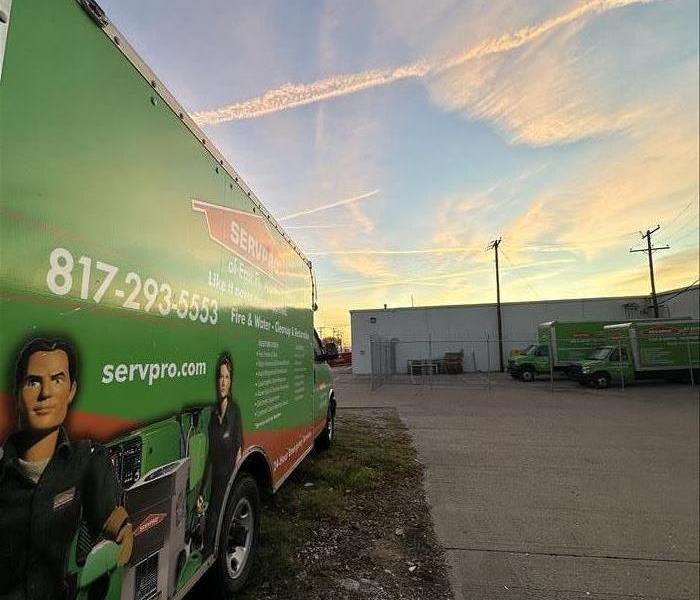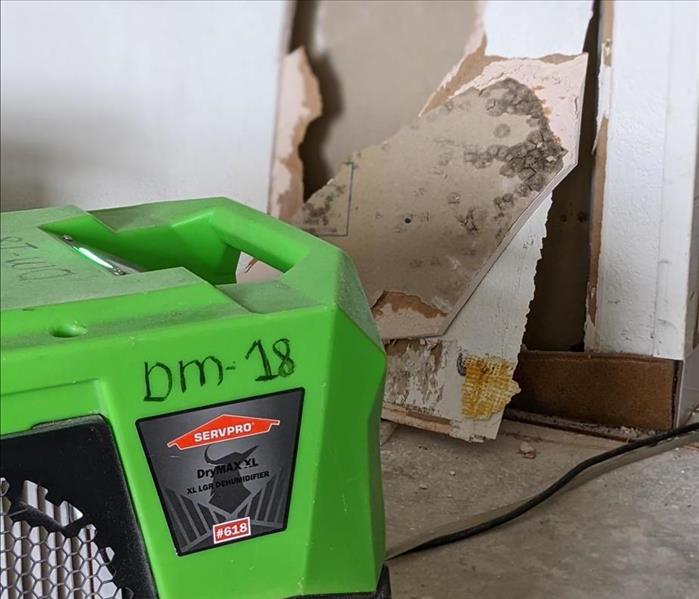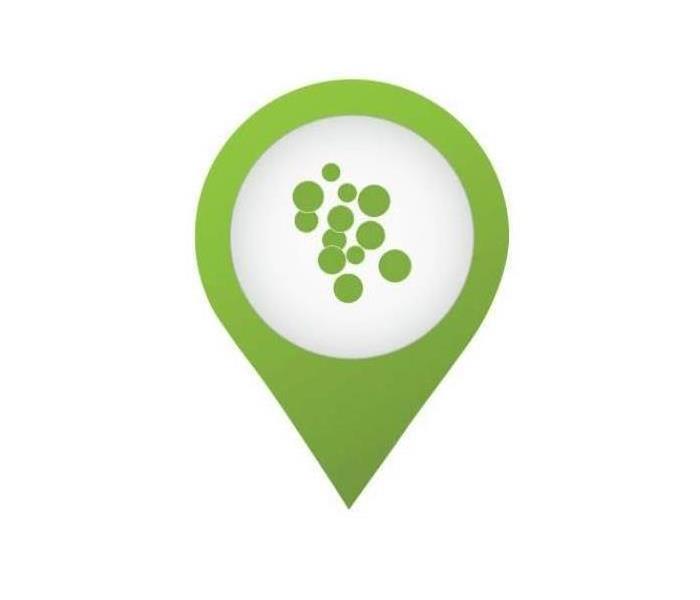Archived Mold Remediation Blog Posts
Black Mold: Myths vs. Facts – Expert Insights from SERVPRO®
11/13/2024 (Permalink)
 n this blog, we will address common misconceptions and provide factual information to ensure you can effectively deal with mold in your home.
n this blog, we will address common misconceptions and provide factual information to ensure you can effectively deal with mold in your home.
Black mold is one of the most commonly discussed types of mold, often sparking concern among homeowners in St. Petersburg, FL. While black mold can be a problem, many myths surround its dangers, identification, and treatment. To help clear up confusion, we’ve compiled expert insights to differentiate myths from facts about black mold. In this blog, we will address common misconceptions and provide factual information to ensure you can effectively deal with mold in your home.
What Is Black Mold?
Black mold, also known as Stachybotrys chartarum, is a type of mold that thrives in damp, humid environments. Like other molds, black mold grows on materials such as wood, drywall, and carpet when moisture is present. Although it has gained a notorious reputation, many misunderstand its true nature.
According to the Environmental Protection Agency (EPA), mold growth can begin within 24-48 hours of moisture exposure, underscoring the importance of quick action when dealing with water damage in the home.
Myth vs. Fact: Common Misconceptions About Black Mold
Myth #1: All Black Mold is Toxic
Fact: Not all black mold is "toxic." While Stachybotrys chartarum has a reputation for being more concerning than other molds, the term "toxic" is often misleading. Black mold itself is not inherently toxic; rather, like other molds, it can grow in areas with significant moisture and can cause damage to your home’s structure over time. It's important to understand that black mold is just one type of many that can grow indoors, and addressing moisture and damage is essential for any kind of mold, not just black mold.
Myth #2: Black Mold is the Only Dangerous Type of Mold
Fact: Black mold is not the only type of mold that can cause structural damage or lead to contamination in your home. Various mold species, such as green, white, or even orange molds, can grow in the same damp environments and should be dealt with promptly. Any type of mold growth can be a serious issue if left unaddressed. Black mold often gets more attention due to its dark appearance and high moisture requirements, but all types of mold need to be removed for the protection of your home.
Myth #3: You Can Identify Black Mold by Its Color Alone
Fact: While black mold is named for its dark color, mold comes in many shades, and not all black-colored mold is Stachybotrys chartarum. Other mold species can appear black or dark green, and identifying mold based solely on color can be misleading. Proper identification typically requires a professional mold assessment to determine the exact type of mold present. If you spot any mold in your home, the most important step is to remove it promptly, regardless of its color.
Myth #4: Small Amounts of Black Mold Are Nothing to Worry About
Fact: Any amount of mold, including black mold, should be taken seriously. Even a small patch of black mold can indicate a moisture problem that could lead to more extensive damage if not addressed. Mold spreads quickly under the right conditions, and what starts as a minor issue can escalate. Mold remediation experts, like SERVPRO®, can assess and remove mold effectively, preventing it from spreading further.
Myth #5: Bleach Can Effectively Eliminate Black Mold
Fact: While bleach may remove the appearance of mold on non-porous surfaces, it does not completely eradicate mold, especially on porous materials like drywall, wood, or carpet. Bleach only works on the surface level, leaving mold roots intact, which can lead to regrowth. Effective mold removal requires professional remediation services to address the underlying moisture problem and thoroughly remove all mold from the affected area.
How to Address Black Mold in Your Home
Understanding how black mold forms and the correct way to handle it is key to keeping your home safe. Here are expert tips for dealing with black mold:
- Identify Moisture Sources: Mold thrives in moist environments, so it’s crucial to locate the source of moisture that is promoting mold growth. Common sources include leaks from roofs, windows, plumbing, or areas with high humidity.
- Act Quickly: Mold can start growing within 24-48 hours of moisture exposure, so addressing water damage promptly is essential. The sooner you take action, the less likely the mold will spread to other areas of your home.
- Call a Professional: Black mold can be difficult to fully remove without the right tools and expertise. SERVPRO specializes in mold remediation, using advanced techniques and equipment to safely remove mold and restore your home.
- Prevent Future Growth: Once the mold is removed, it's important to prevent future mold growth by controlling humidity, repairing leaks, and ensuring proper ventilation in areas like bathrooms, kitchens, and basements.
Trust SERVPRO for Expert Black Mold Remediation
Mold, whether black or another variety, is a serious issue that should not be ignored. At SERVPRO, we specialize in professional mold remediation services designed to tackle mold growth at its source and prevent future problems. With years of experience and state-of-the-art equipment, we’re equipped to safely and effectively handle all types of mold in your home.
By understanding the myths and facts surrounding black mold, you can take the necessary steps to protect your home. If you suspect black mold or any other type of mold in your home, contact SERVPRO today for a professional assessment and remediation.
Don't let myths about black mold lead to misinformation. Knowing the facts can help you make informed decisions to keep your home safe from mold damage. For expert help, trust SERVPRO to handle your mold remediation needs with experience, expertise, and care.
Discovering Safe Mold Cleaning Products for Your Home: A Comprehensive Guide
7/10/2024 (Permalink)
 We explore some safe mold cleaning products that you can use to tackle mold growth in your home.
We explore some safe mold cleaning products that you can use to tackle mold growth in your home.
Dealing with mold growth in your home can be a challenging task, but choosing the right cleaning products can make the process safer and more effective. With so many options available, it's essential to select mold-cleaning products that are not only effective but also safe for your family and the environment. In this blog post, we'll explore some safe mold cleaning products that you can use to tackle mold growth in your home.
Understanding Safe Mold Cleaning Products
Vinegar
Vinegar is a natural and effective mold-cleaning solution that is safe to use in your home. Its acidic properties help to kill mold spores and prevent regrowth. Simply mix equal parts white vinegar and water in a spray bottle and apply it to moldy surfaces. Allow it to sit for several hours before wiping it clean with a damp cloth.
Hydrogen Peroxide
Hydrogen peroxide is another safe and environmentally friendly option for mold cleaning. It has antifungal properties that make it effective at killing mold spores. Mix hydrogen peroxide with water in a spray bottle and apply it to moldy surfaces. Allow it to sit for 10-15 minutes before scrubbing with a brush and rinsing with water.
Baking Soda
Baking soda is a versatile cleaning agent that can help remove mold and mildew from surfaces in your home. Its abrasive texture helps to scrub away mold stains, while its alkaline properties help to neutralize odors. Mix baking soda with water to form a paste and apply it to moldy surfaces. Scrub gently with a brush and rinse with water.
Tea Tree Oil
Tea tree oil is a natural antifungal and antibacterial agent that can effectively kill mold spores and inhibit regrowth. Mix a few drops of tea tree oil with water in a spray bottle and apply it to moldy surfaces. Allow it to sit for several hours before wiping it clean with a damp cloth.
Grapefruit Seed Extract
Grapefruit seed extract is a natural disinfectant that can help kill mold spores and prevent their regrowth. Mix a few drops of grapefruit seed extract with water in a spray bottle and apply it to moldy surfaces. Allow it to sit for several hours before wiping it clean with a damp cloth.
Tips for Using Safe Mold Cleaning Products
Always Wear Protective Gear:
When using mold cleaning products, it's essential to wear protective gear such as gloves, goggles, and a mask to prevent exposure to mold spores and cleaning chemicals.
Test in a Small Area:
Before using any mold cleaning product on a large area, test it in a small, inconspicuous area to ensure that it does not cause any damage or discoloration to the surface.
Follow the Manufacturer's Instructions:
Always follow the manufacturer's instructions when using mold cleaning products. Use the recommended dilution ratios and application methods for best results.
Using safe and effective mold cleaning products is essential for maintaining a healthy indoor environment in your home. By choosing natural and environmentally friendly options such as vinegar, hydrogen peroxide, baking soda, tea tree oil, and grapefruit seed extract, you can effectively tackle mold growth while minimizing exposure to harmful chemicals. If you're dealing with extensive mold growth or have concerns about cleaning products, don't hesitate to contact a professional restoration company like SERVPRO® for expert assistance.
10 Key Facts About Mold
9/27/2021 (Permalink)
10 Key Facts About Mold
- Mold exposure may cause health effects.
- There is no practical way to eliminate all mold and mold spores in the indoor environment; the way to control indoor mold growth is to control moisture.
- If mold is a problem in your home or school, you must clean up the mold and eliminate moisture sources.
- Fix the source of the water problem or leak to prevent mold growth.
- Reduce indoor humidity (to 30-60%) to decrease mold growth by:
- Venting bathrooms, dryers, and other moisture-generating sources to the outside
- Using air conditioners and de-humidifiers
- Increasing ventilation
- Using exhaust fans whenever cooking, dishwashing, and cleaning.
- Clean and dry any damp or wet building materials and furnishings within 24-48 hours to prevent mold growth.
- Clean mold off hard surfaces with water and detergent and dry thoroughly. Absorbent materials such as ceiling tiles that are moldy may need to be replaced.
- Prevent condensation: Reduce the potential for condensation on cold surfaces (i.e., windows, piping, exterior walls, roof, or floors) by adding insulation.
- In areas where there is a perpetual moisture problem, do not install carpeting (i.e., by drinking fountains, classroom sinks, or on concrete floors with leaks or frequent condensation).
- Molds can be found almost anywhere; they can grow virtually any substance, providing moisture is present. Some molds can grow on wood, paper, carpet, and foods.
Eliminating Mold Growth Causes
9/21/2021 (Permalink)
SERVPRO Remediates Mold Damage and Takes Steps to Prevent Future Mold Growth
A continuous state of elevated humidity is a primary cause of excessive microbial growth in Gulf Beaches South / West St. Petersburg residences. It can quickly increase the amount of damage that follows. Other factors, such as the presence of absorbent materials in the home, can also play a role in how rapidly microbial growth occurs.
Whenever a residence in Gulf Beaches South / West St. Petersburg sustains mold damage, one of the aspects examined inside the home includes water sources' presence. Leaky water lines, past flooding events, and saturated ground near the home can increase the amount of humidity the interior of the home experiences. SERVPRO technicians use moisture meters and other devices to locate the sources and areas where moisture accumulated. Once we discover these areas and sources, we can then resolve the situation that caused microbial growth to affect the home.
Mold remediation experts know that the existence of future invasive water can cause the microbial problem to return, rendering mold remediation efforts useless. Once we eliminate these sources, we can then begin removing mold-damaged materials, laundering and cleaning household items and furniture, and caring for the carpeting throughout the home. Walls that harbor mold, even if dormant, need cleaning and drying.
During our work, maintaining a set of controls to keep all mold contained safely affects our labor's overall outcome. Containment includes plastic sheeting and air scrubbers usage surrounding areas within the home. Sending microbes outdoors helps keep them from entering other areas of your property.
However, ensuring that moisture sources no longer exist should not help keep old sources from returning in full force. Effectively starving microbes, their population growth stays under control. Once we complete our remediation work, diligent homeowners know to keep an eye out for leaking water lines, loose connections, and other sources of moisture. Microbes do not need a great deal of moisture to begin growing again and causing future problems.
SERVPRO of Gulf Beaches South / West St. Petersburg is always ready to serve those in our community. Contact us by calling our 24-hour service line at (727) 341-1001. Your family does not need to live with the effects of mold damage in your home.
Why You Should Choose SERVPRO to Handle Your Property's Mold
2/3/2021 (Permalink)
 If you have mold, contact SERVPRO of Gulf Beaches South / West St. Petersburg.
If you have mold, contact SERVPRO of Gulf Beaches South / West St. Petersburg.
Before we begin to tell you why you should choose SERVPRO to handle your property's mold, let's start with what mold is. Mold is a living organism belonging to the kingdom fungi. Due to mold not capable of making its food, it has to gain its nutrients from other substances. Mold is composed of thread-like filaments called hyphae. The hyphae then form a conglomerate called a mycelium. While mold itself has no mobility, its hyphae can grow quite large. Why should you choose SERVPRO to handle your property's mold? We can give you two reasons:
#1 We Are Highly Trained Mold Remediation Specialists
SERVPRO professionals specialize in water and mold damage restoration. We have Applied Microbial Remediation Specialist, Water Damage Restoration Technician, and Applied Structural Drying Technician training and expertise to safely handle any mold situation.
#2 We Use Advanced Mold Remediation Techniques and Equipment
While every mold damage scenario is different and requires a unique solution, the general mold remediation process stays the same.
Step 1: Emergency Contact 1-833-683-4550
The mold cleanup and restoration process begin when you call our National Customer Care Center to receive all the information needed to begin the process.
Step 2: Inspection and Mold Damage Assessment
SERVPRO professionals will carefully inspect your property for visible signs of mold.
Related: Warning Signs You Have A Mold Problem
Step 3: Mold Containment
SERVPRO professionals will use various containment procedures to prevent the spread of mold in your house.
Step 4: Air Filtration
Their specialized filtration equipment allows their professionals to capture microscopic mold spores out of the air. They utilize powerful "air scrubbers" and HEPA vacuums to prevent these mold spores' spread while the mold remediation is in process.
Step 5: Removing Mold and Mold-Infested Materials
The mold remediation process depends on the amount of mold growth and the types of surfaces on which the mold appears. Removing and disposing of mold-infested porous materials, like drywall and carpeting, may be necessary to remediate heavy mold growth.
Step 6: Cleaning Contents and Belongings
SERVPRO professionals will clean your furniture, decorative items, curtains, clothing, and other restorable items affected by mold.
Step 7: Restoration
Depending on the mold damage level, drywall, subfloors, and other building materials may need removal. Restoration may involve minor repairs such as painting or installing new carpet, or it may entail major repairs such as reconstructing various areas or rooms in a home or business.
 n this blog, we will address common misconceptions and provide factual information to ensure you can effectively deal with mold in your home.
n this blog, we will address common misconceptions and provide factual information to ensure you can effectively deal with mold in your home.





 24/7 Emergency Service
24/7 Emergency Service

